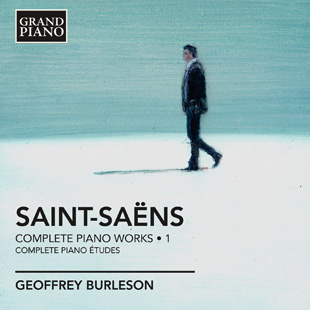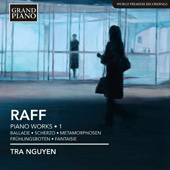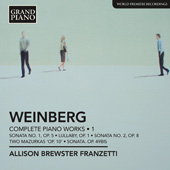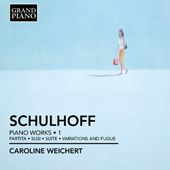
Saint-Saëns
COMPLETE PIANO WORKS • 1 Saint-Saëns' music has captivated me ever since I learned his Allegro Appassionato as a teenager. The breadth of his ingenious piano works never fails to amaze me, as it simultaneously encompasses classical, romantic and modern sensibilities so compellingly. Saint-Saëns was also a groundbreaking innovator in the realm of piano technique, creating formidable but also invaluable challenges for the performer. It has been rewarding on all levels to immerse myself in the works of one of the greatest piano composers for this project. – Geoffrey Burleson "Burleson plays with enormous flair and style... superb!" |
 |
|
 |
ABOUT THIS RELEASE
A seminal figure in the history of French Romantic music, Camille Saint-Saëns was also one of the greatest keyboard prodigies of the past two hundred years. Liszt referred to him as the greatest organist on earth. Over the course of more than forty years, Saint-Saëns wrote three sets of ingenious, groundbreaking piano études. His initial Six Études, Op. 52 were written in 1877, when Saint-Saëns was already a mature composer. No. 1 Prélude opens with exuberant, unrestrained virtuosity, and a "testing" of all registers of the keyboard. No. 3 Prelude and Fugue in F minor showcases one of Saint-Saëns' most central talents: writing keyboard music in the Baroque style, while still bringing original elements of structure, counterpoint and more Romantic textures to the fore. Saint-Saëns next set of etudes, Six Études, Op. 111, only arrived 22 years later. The concluding, brilliant Toccata is a transformation of the last movement of his Piano Concerto No. 5, a very difficult rondo that relentlessly explores many bravura techniques and textures. It serves as a fantastic culmination of the preceding études, in that it embeds so many of the techniques found in the first five études. In 1912, Saint-Saëns wrote the Six Études for the Left Hand Alone, Op. 135, for Madame Caroline de Serres, whom he often performed duo piano works with. These are very different in character, spirit and musical language from the preceding etudes. The Élégie is filled with great variety, invention and poignant lyricism. The concluding Gigue is a very effective closer, impishly fading out in its coda into the depths of the piano's register.
|
Six Études, Op. 52 (1877) 27:02 Six Études, Op. 111 (1899) 21:21
|
11. Prélude: Moderato agitato – 01:37 Six Études pour la main gauche seule, Op. 135 (1912) 19:04 TOTAL TIME: 67:27 |
 |
ABOUT THE ARTIST
Geoffrey Burleson has performed to wide acclaim throughout Europe and North America, and is equally active as a recitalist, concerto soloist, chamber musician and jazz performer. His numerous solo appearances include prominent venues in Paris, New York, Rome, Athens, Mexico City, Rotterdam, Chicago, Boston, Washington, Switzerland, England, Spain, and elsewhere. His appearances as concerto soloist include the Boston Musica Viva, Arlington Philharmonic, New England Philharmonic, and the Holland Symfonia in The Netherlands. A laureate of the International Piano Recording Competition (Silver Medal), and the Vienna Modern Masters International Performers' Competition, he was also the recipient of a DAAD Grant from the German government to support a residency at the Academy of Arts in Berlin. His recordings include the complete piano music of Roy Harris for Naxos. "A top-notch pianist. Burleson's piquancy and poetry blended beautifully." |
| Grand Piano is a new premium label dedicated to the exploration of undiscovered keyboard repertoire. Pulling from a deep pool of talent around the globe, Grand Piano brings to life exciting interpretations of these gems of the piano repertoire. Grand Piano will release around 20 new titles each year, including many world premières and complete cycles. | ||||||
|
||||||
| For enquiries contact info@grandpianorecords.com |



